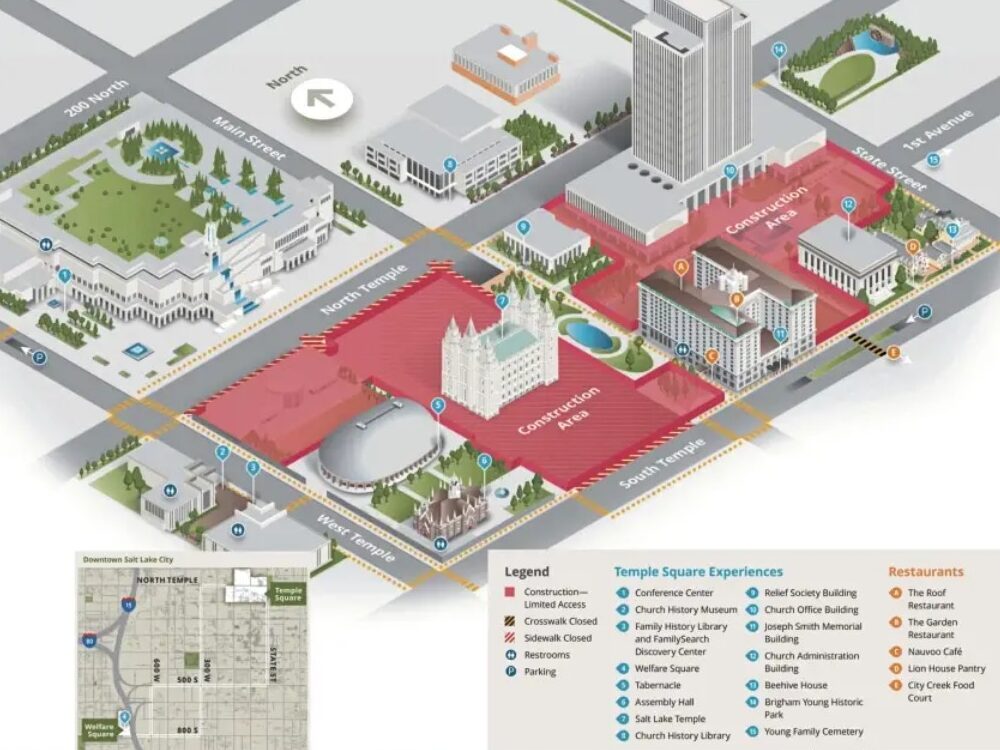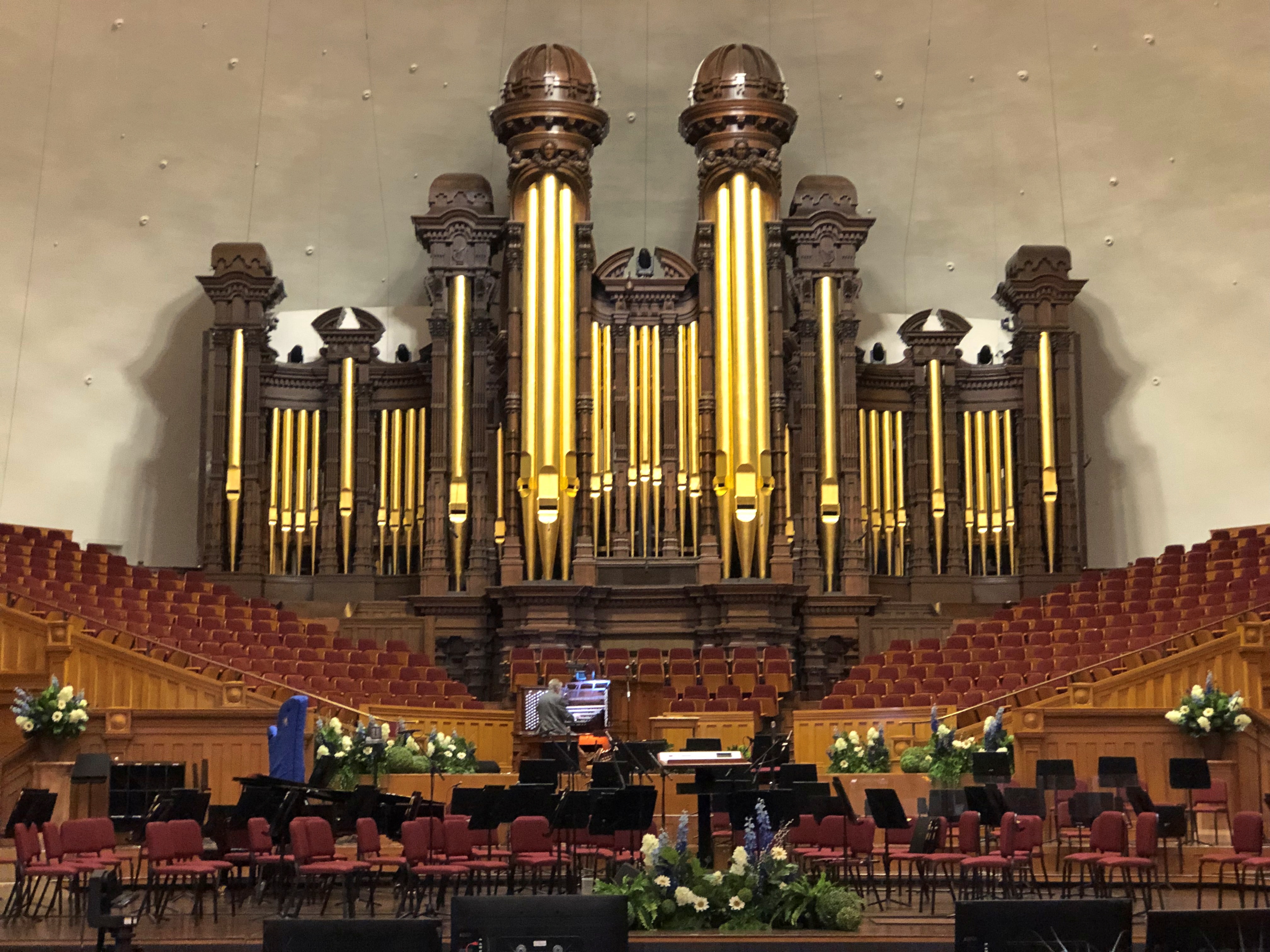The wide balconies of the LDS Conference Center in Salt Lake City look over at the rest of Temple Square and its centerpiece, the Salt Lake Temple, which happens to be behind scaffolding right now. Not the first noteworthy place I’ve seen in that condition.

On the morning of May 21, we caught the temple at a moment of reconstruction, or rather a few years of it: a restoration and seismic refitting that will continue into the mid-years of this decade at least. Standing there for about 130 years now, the church must have decided it was time, despite earlier renovations. The building next door is the handsome Joseph Smith Memorial Building, built as the Hotel Utah in 1911, now an event venue.
We started our walk around Temple Square that morning on the other side of the Temple. This schematic by the church was posted on site to let you know that much of the area is closed for the reconstruction.
There was more to Temple Square than I remembered. There was more to Salt Lake City, for that matter. Considering that the last time I visited was 1980, that isn’t much of a surprise. After that much time, you might as well be visiting for the first time.
Yet I remember parts of the first time fairly well: an overnight excursion from Logan, Utah, not far to the north, in the company of Tom Jones. He attended Utah State University in Logan in those days, and that June I took a bus from San Antonio and back to visit him and — of course — see that part of the country for the first time. Two years later, I visited again as part of a much longer trip, also by bus, but didn’t go to SLC that time.
Salt Lake Temple stands out in my memory of 1980, as it stands out in the heart of the city for reasons other than mere height. I’m sure it loomed even larger 40-plus years ago than now, when downtown wasn’t as populated by as many tall buildings as it is now.
I checked — you have to love Wiki, this is the kind of thing it excels at — and fully 21 of the 39 tallest structures in SLC were developed after 1980, and another two were completed that year. The Salt Lake Temple wasn’t the tallest structure in the city then either, a distinction it held only for about a year in the 19th century.
The Temple might be closed, but it’s closed all the time to non-Mormons anyway. In 1980, we visited the North Visitors Center, a multistory building full of murals depicting the church’s novel theology, culminating in 11-foot replica of Bertel Thorvaldsen’s Christus statue in front of a celestial background.
That building lasted from 1963 to last year, when it was torn down as part of the work at Temple Square. The statue will be located elsewhere in the square, though for now a smaller-sized model is on view at the Conference Center.
The first place we saw at the square was the Salt Lake Assembly Hall.

Not a church building per se — or maybe it is — but in any case various LDS functions have been held there down the years since the early 1880s. A Gothic design by an early Mormon convert, one Obed Taylor. That’s a good old Biblical name that needs to be brought back, millennials. It’s not to late to name a kid or two of yours Obed (or Boaz, for that matter).

Impressive, but the Salt Lake Tabernacle is even more so, though its exterior reminds me of nothing more than a silver pill bug.

“Brigham Young, who was the Church President at the time of construction, proposed the original design idea of a large dome building with no columns to interfere with the line of sight to the podium,” the LDS web site says. “Bridge builder Henry Grow used a lattice truss design so the Tabernacle roof was able to span its 150-foot width without center supports.” 

The building used to be used for mass general meetings of the church, but they were moved to the Conference Center in 2000. The Tabernacle Choir — known to the world as the Mormon Tabernacle Choir — still performs in the silver pill bug. While we were visiting, an organist noodled bits of a few tunes on 11,623-pipe organ, such as (naturally) Toccata and Fugue in D Minor. An epic sound.
“The current instrument – the fourth organ to sit inside the organ case – was built in 1948 by the Æolian-Skinner Organ Co. of Boston,” notes the Tabernacle web site FAQ. “One hundred and twenty-two pipes from the original Joseph Ridges organ and another dozen from the 1885 Niels Johnson additions to the organ remain in use today. The 10 largest façade pipes, which date back to the original Ridges organ, do play.”
The last place we visited at Temple Square was the impressively large Conference Center, which as far as I can tell is simply The Conference Center. At 1.4 million square feet, it’s a whopper, including its 21,200-seat main auditorium, where the church holds its biannual general conference and other major gatherings. Design by ZGF Architects of Portland, Oregon.

Though not the size of the Tabernacle organ, the auditorium organ is no slouch at 7,708 pipes. I have no way to judge whether the following Wiki statement is true, but I’m passing it along anyway because it sure sounds impressive: “This organ is internationally significant… in that it is the only organ in the world that has 2 registers of pipes extending down into the 64′ series, the 64′ Contra Trombone and 64′ Contra Gamba, which both extend 4 pipes down to GGGGG#, 13 semitones below the lowest note on a standard piano.”
The Christus statue formerly at the visitor center may be in storage, but a smaller replica is on view on one of the Conference Center floors, along with busts of LDS luminaries and murals of Jesus in the New World.

Did I forget to mention the presence of Mormon missionaries in all of these buildings? Not skinny young men in white shirts and black ties, but pleasantly dressed young women, in pairs like the men, and from different parts of the world, according to their badges.
We were greeted by them in each building, and in the case of the Conference Center, each floor of the building. I chatted a few minutes with the first of these, in the Assembly Hall. I knew perfectly well they were missionaries, out to assess my interest in things LDS and put a fresh young face on this most successful sect of the 19th-century American effusion of creative religious enthusiasm. I’m no expert on Mormonism, but they probably found that I knew more about it — including the Golden Tablets, the early church goings-on in Nauvoo, the migration west — than most non-Mormons wandering in.
Before long, though, I was telling the first pair about how I like to visit religious sites anywhere I go, and recommended a few obvious ones to them, such as St. Peter’s in Rome, St. Paul’s in London, the Daibutsu in Nara and Borobudur on Java, but also not to ignore the smaller sites you happen across. Maybe not something they hear all the time from visitors, either. Yuriko had much less patience with the missionaries, and whenever I happened to speak with a pair, she usually was on her way.
